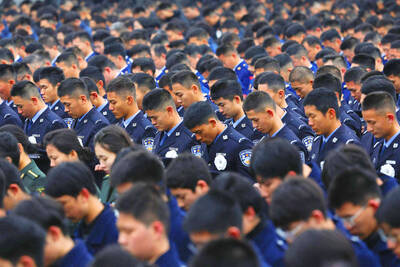They were hopelessly outnumbered, but even then the Greeks knew it would be the battle that could change history.
The Asian invaders, had entered the Aegean. The "comeliest of boys" had been castrated; the throats of the "goodliest" soldiers ripped out.
Mounted on his marble throne Xerxes, Persia's formidable warrior king looked over the bay of Salamis, confident that he was about to enslave Europe. But instead of victory came defeat.
As the Greeks' triremes trapped the Asian fleet, smashing it with their bronze rams, Xerxes watched incredulously. His soldiers, he said, were fighting like women.
That was 480 BC. Nearly 2,500 years later, the quest to better understand the battles that the victorious Greeks would see as a defining point in their history has reached new heights, as experts Sunday began searching for the lost fleets of the campaign in the northern Aegean.
In the world of underwater archaeology the hunt for the legendary armadas is the expedition that might, just, scoop all others.
Topping the international team's wish-list is the remains of a trireme, the pre-eminent warship of the classical age.
"This is high-risk archaeology," says Shelly Wachsmann of Texas A&M University, the team's co-leader. "Discovering a trireme is one of the holy grails. Not one has ever been found."
The Persians' defeat at Salamis is seen as one of the first victories of democracy over tyranny, a crucial moment in Western history.
Without it, say academics, there would have been no Golden Age and the world would have been a very different place.
All of which makes this week-long mission more poignant as experts try to find out how the Greeks managed to defeat a much bigger and better-equipped enemy.
Although archaeologists have discovered ancient Greek and Persian ships, they have always been cargo vessels.
For their guide around three of the five sites where Persian and Greek vessels are believed to have sunk -- the Magnesian coast of Thessaly, Artemision in northern Euboea and the "hollows of Euboea" -- the scholars have Herodotus.
Known as the father of history, the 5th century BC historian chronicled the wars in his masterpiece, The Histories. However, although his story is a good read, few artifacts have emerged to support it.
"This is a reversal of how we usually work, in that we know the history but lack the physical evidence," says Katerina Delaporta who heads Greece's Ephorate of Underwater Antiquities and is also co-leading the project.
Previously, she said, the search would have been impossible because of the technical requirements involved. With the passage of time and the Aegean's unpredictable weather conditions, maritime experts believe the wrecks will be buried under mud and silt. That means surveying the seabed at depths of up to 600m where visibility is limited. Among the team's state-of-the art equipment are sonar scans, a two-man submersible and a remote-operated vehicle capable of sending video messages to the surface.
"This is the first time such sophisticated technology is being employed," Delaporta said.
More than 1,000 of the three-tiered triremes participated in the second Persian war.
But while ship sheds and dry docks have been unearthed, scholars have had to make do with images of the galley on pottery. The discovery of a trireme, either Greek or Persian, would not only unravel the mysteries of antiquity's greatest fighting vessel but shed light on the civilization.
"Ships throughout time are among the most complex artifacts that any culture creates," Wachsmann said.
Although the sea is more difficult to explore, it has the benefit of preserving artifacts better than if they were on land. Among the assembled geologists, archaeologists, historians and oceanographers there is no doubt that the ancient shipwrecks exist.
"It's just a question of finding them," said Stefanie Kennell, the director of the Canadian Archaeological Institute.
Because triremes had very little ballast, and when destroyed were unlikely to sink but float, archaeologists have long debated the likelihood of finding one. Most have set their hopes on finding a bronze ram, or the arms and armor that went down with the crews.
"If we can find part, or even the metal fittings of a trireme, it would add immeasurably to our knowledge of military seafaring in the early 5th century BC," Kennell said.
In an earlier attempt to find the lost Persian fleet of the first Persian war -- wrecked off Mount Athos in a storm in 492 BC -- the searchers discovered two helmets and a bronze-tipped spear butt.
But around Mount Athos, the waters were much deeper.
"The chances of making more finds are higher," Delaporta said.
The big prize - -- Salamis -- has been left for now. But time, she says, is of the essence. With the technological advances a new kind of menace has arrived -- looters, rushing to beat the academics to the ancient wrecks.

The Burmese junta has said that detained former leader Aung San Suu Kyi is “in good health,” a day after her son said he has received little information about the 80-year-old’s condition and fears she could die without him knowing. In an interview in Tokyo earlier this week, Kim Aris said he had not heard from his mother in years and believes she is being held incommunicado in the capital, Naypyidaw. Aung San Suu Kyi, a Nobel Peace Prize laureate, was detained after a 2021 military coup that ousted her elected civilian government and sparked a civil war. She is serving a

China yesterday held a low-key memorial ceremony for the 1937 Nanjing Massacre, with Chinese President Xi Jinping (習近平) not attending, despite a diplomatic crisis between Beijing and Tokyo over Taiwan. Beijing has raged at Tokyo since Japanese Prime Minister Sanae Takaichi last month said that a hypothetical Chinese attack on Taiwan could trigger a military response from Japan. China and Japan have long sparred over their painful history. China consistently reminds its people of the 1937 Nanjing Massacre, in which it says Japanese troops killed 300,000 people in what was then its capital. A post-World War II Allied tribunal put the death toll

‘NO AMNESTY’: Tens of thousands of people joined the rally against a bill that would slash the former president’s prison term; President Lula has said he would veto the bill Tens of thousands of Brazilians on Sunday demonstrated against a bill that advanced in Congress this week that would reduce the time former president Jair Bolsonaro spends behind bars following his sentence of more than 27 years for attempting a coup. Protests took place in the capital, Brasilia, and in other major cities across the nation, including Sao Paulo, Florianopolis, Salvador and Recife. On Copacabana’s boardwalk in Rio de Janeiro, crowds composed of left-wing voters chanted “No amnesty” and “Out with Hugo Motta,” a reference to the speaker of the lower house, which approved the bill on Wednesday last week. It is

FALLEN: The nine soldiers who were killed while carrying out combat and engineering tasks in Russia were given the title of Hero of the Democratic People’s Republic of Korea North Korean leader Kim Jong-un attended a welcoming ceremony for an army engineering unit that had returned home after carrying out duties in Russia, North Korean state media KCNA reported on Saturday. In a speech carried by KCNA, Kim praised officers and soldiers of the 528th Regiment of Engineers of the Korean People’s Army (KPA) for “heroic” conduct and “mass heroism” in fulfilling orders issued by the ruling Workers’ Party of Korea during a 120-day overseas deployment. Video footage released by North Korea showed uniformed soldiers disembarking from an aircraft, Kim hugging a soldier seated in a wheelchair, and soldiers and officials